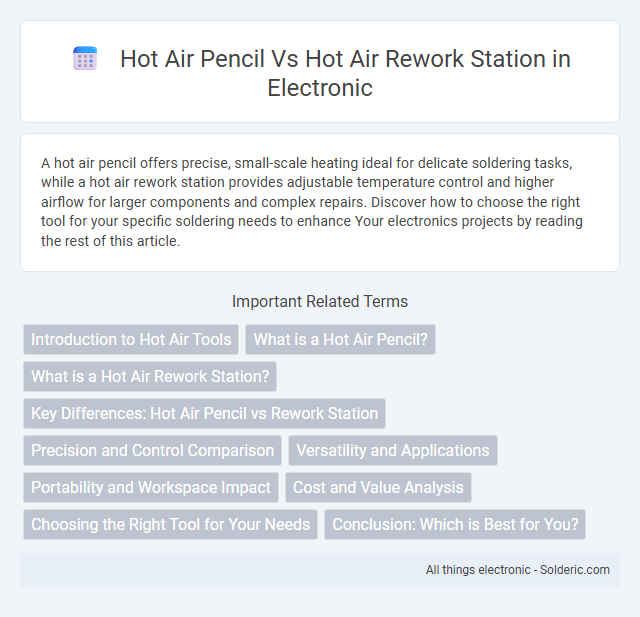A hot air pencil offers precise, small-scale heating ideal for delicate soldering tasks, while a hot air rework station provides adjustable temperature control and higher airflow for larger components and complex repairs. Discover how to choose the right tool for your specific soldering needs to enhance Your electronics projects by reading the rest of this article.
Comparison Table
| Feature | Hot Air Pencil | Hot Air Rework Station |
|---|---|---|
| Usage | Precision soldering and small component work | Large PCB and surface mount device (SMD) rework |
| Temperature Control | Limited or fixed temperature settings | Adjustable temperature with digital display |
| Airflow | Low airflow, focused | High airflow, adjustable for different tasks |
| Power | Typically 150-200W | Typically 500W or higher |
| Portability | Compact and lightweight | Less portable; bulky station setup |
| Cost | Affordable, budget-friendly | More expensive, professional-grade |
| Ideal For | Hobbyists and minor repair jobs | Professional technicians and heavy-duty repairs |
Introduction to Hot Air Tools
Hot air pencils and hot air rework stations are essential tools for precise soldering and desoldering tasks in electronics repair and assembly. Hot air pencils offer focused heat output ideal for small components, while hot air rework stations provide adjustable temperature and airflow control suited for larger, more complex boards. Both tools utilize controlled hot air to melt solder without direct contact, minimizing damage and enhancing efficiency.
What is a Hot Air Pencil?
A Hot Air Pencil is a compact soldering tool designed for precise heating and soldering tasks, ideal for delicate electronics repair and rework. Unlike a traditional Hot Air Rework Station, it delivers focused hot air through a narrow tip, allowing accurate control over small components without affecting surrounding areas. This makes it particularly effective for tasks like heat shrinking, soldering tiny surface-mounted devices, and removing adhesives.
What is a Hot Air Rework Station?
A Hot Air Rework Station is a specialized tool designed for precise soldering and desoldering of electronic components using controlled hot air flow. Unlike a simple hot air pencil, it offers adjustable temperature settings and airflow control, ensuring safer and more efficient rework on sensitive circuit boards. Your repair projects benefit from its accuracy, reducing the risk of damage during component removal or replacement.
Key Differences: Hot Air Pencil vs Rework Station
Hot air pencils provide a compact, handheld tool ideal for precise soldering and delicate component work due to their smaller nozzle and lower airflow. Hot air rework stations offer adjustable temperatures and higher airflow rates, suited for larger-scale desoldering and reflow of circuit boards with better temperature stability. The main differences lie in the tool size, airflow control, and versatility for varying soldering tasks.
Precision and Control Comparison
Hot air pencils offer higher precision and control for delicate soldering tasks due to their compact nozzle and lower airflow, making them ideal for microelectronic components and localized heat application. In contrast, hot air rework stations provide adjustable temperature and airflow settings but generally cover a broader area, which can reduce fine control during intricate repairs. Professionals often choose hot air pencils for precision soldering, while hot air rework stations are preferred for versatility and larger-scale desoldering jobs.
Versatility and Applications
A hot air pencil offers precise heat delivery suitable for delicate soldering tasks and small-scale repairs, making it ideal for intricate component work such as SMD reflow and micro-soldering. In contrast, a hot air rework station provides adjustable temperature and airflow controls along with interchangeable nozzles, catering to a broader range of applications including desoldering larger components, PCB rework, and heat shrink tubing. The rework station's versatility supports more extensive repair and assembly processes across diverse electronic devices, whereas the hot air pencil is optimized for precision and compact operations.
Portability and Workspace Impact
Hot air pencils offer superior portability due to their compact size and lightweight design, making them ideal for on-the-go repairs or limited workspace environments. Hot air rework stations, while more powerful, typically occupy significant desk space and require stable power sources, impacting your overall workspace setup. Choosing between the two depends on balancing portability needs against workspace capacity and the complexity of your projects.
Cost and Value Analysis
A hot air pencil generally costs less than a hot air rework station, making it a budget-friendly option for small, precise tasks such as soldering or heat shrinking. Hot air rework stations offer greater temperature control, airflow options, and versatility, providing significant value for professionals handling complex electronics repairs. Your choice depends on balancing upfront cost with long-term productivity and flexibility in electronic rework projects.
Choosing the Right Tool for Your Needs
Hot air pencils offer precise heat application ideal for small, delicate soldering tasks, making them perfect for intricate repairs and component rework. Hot air rework stations provide adjustable temperature control and higher airflow capacity, suited for larger-scale desoldering and PCB modifications. Consider your typical project size and heat precision requirements to determine whether a hot air pencil or rework station better matches your workflow.
Conclusion: Which is Best for You?
A hot air pencil offers precise, small-scale soldering ideal for delicate electronics and intricate repairs, while a hot air rework station provides versatile, adjustable airflow and temperature controls suited for larger components and complex circuit boards. Consider your typical project scope: use a hot air pencil for fine detail work and compact areas, but opt for a rework station if you frequently handle multi-layered PCBs or perform extensive surface-mount device (SMD) rework. Matching tool capabilities to your repair or assembly needs ensures optimal performance and efficiency in electronics maintenance.
Hot air pencil vs hot air rework station Infographic

 solderic.com
solderic.com